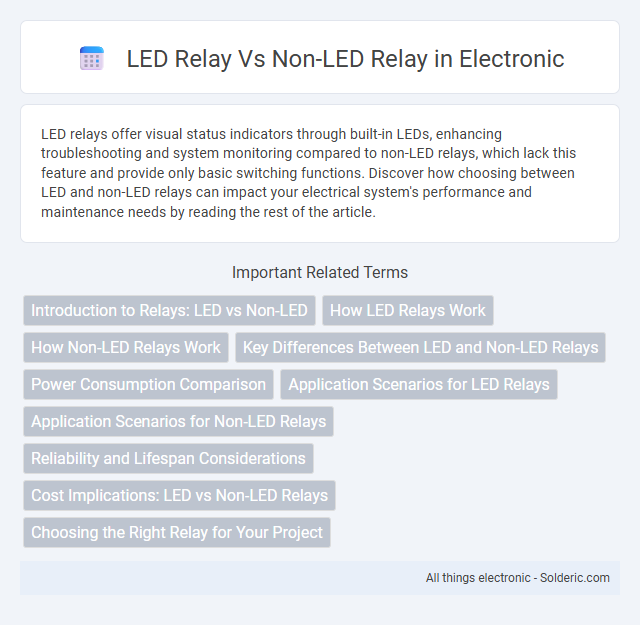LED relays offer visual status indicators through built-in LEDs, enhancing troubleshooting and system monitoring compared to non-LED relays, which lack this feature and provide only basic switching functions. Discover how choosing between LED and non-LED relays can impact your electrical system's performance and maintenance needs by reading the rest of the article.
Comparison Table
| Feature | LED Relay | Non-LED Relay |
|---|---|---|
| Visual Status Indicator | Yes, built-in LED shows relay activation | No visual indicator |
| Power Consumption | Slightly higher due to LED | Lower power, no LED load |
| Diagnostic Convenience | Easy troubleshooting via LED signal | Requires external testing tools |
| Cost | Generally higher price | Lower cost, basic functionality |
| Reliability | Similar mechanical reliability | High reliability without LED |
| Applications | Control panels, automation systems | Basic switching applications |
Introduction to Relays: LED vs Non-LED
Relays are electromechanical switches used to control circuits by opening or closing contacts in response to an electrical signal. LED relays incorporate a light-emitting diode to provide a visual indication of the relay's activation status, enhancing troubleshooting and monitoring. Non-LED relays lack this feature, focusing solely on switching functionality without built-in status indication.
How LED Relays Work
LED relays work by using a light-emitting diode to trigger the internal switching mechanism, providing a visual indication of the relay's activation status. This design improves operational transparency and simplifies troubleshooting by allowing You to easily see when the relay coil is energized. Compared to non-LED relays, LED relays enhance safety and reliability by minimizing the risk of coil damage and electrical noise interference.
How Non-LED Relays Work
Non-LED relays operate by using an electromagnetic coil that generates a magnetic field when current passes through it, causing an armature to move and open or close electrical contacts. Unlike LED relays, they do not have built-in light-emitting diodes for visual status indication, relying solely on mechanical switching. This design allows non-LED relays to control high-current circuits without providing immediate feedback on the relay's operational status.
Key Differences Between LED and Non-LED Relays
LED relays feature built-in light-emitting diodes that provide visual indication of coil activation, enhancing troubleshooting and status monitoring compared to non-LED relays. Non-LED relays lack this visual feedback, relying solely on external testing or circuit diagnostics to verify operation. The presence of an LED in relays improves efficiency in maintenance and reduces downtime by allowing quick verification of relay status at a glance.
Power Consumption Comparison
LED relays consume significantly less power than non-LED relays due to the low energy requirements of their integrated light-emitting diodes, which indicate relay status without adding substantial electrical load. Non-LED relays typically rely on larger electromagnetic coils that draw higher current continuous power during operation, resulting in increased energy consumption. This difference makes LED relays more energy-efficient and suitable for applications where minimizing power usage is critical.
Application Scenarios for LED Relays
LED relays are ideal for applications requiring visual status indicators, such as industrial automation, HVAC systems, and control panels, where monitoring relay activation is crucial. Their integrated LED provides immediate feedback, enhancing troubleshooting efficiency and operational safety in environments with limited accessibility. You benefit from reduced downtime and easier maintenance in systems demanding clear signal confirmation.
Application Scenarios for Non-LED Relays
Non-LED relays are ideal for applications where basic switching functions are required without the need for visual status indicators, such as in industrial machinery or automotive systems. These relays offer reliable performance in environments where space constraints or budget considerations prohibit the use of LED indicators. You can optimize your system's efficiency by selecting non-LED relays for straightforward control tasks that do not demand immediate operational feedback.
Reliability and Lifespan Considerations
LED relays offer enhanced reliability and longer lifespan due to their solid-state design, which minimizes mechanical wear and reduces failure rates compared to traditional non-LED electromechanical relays. The absence of moving parts in LED relays prevents contact degradation and ensures consistent performance under high cycling conditions, making them ideal for applications requiring durability. Non-LED relays, while often simpler and cost-effective, typically experience shorter operational life spans due to mechanical contact fatigue and susceptibility to environmental factors like dust and vibration.
Cost Implications: LED vs Non-LED Relays
LED relays typically have higher upfront costs compared to non-LED relays due to the additional electronic components and enhanced durability features they offer. However, the energy efficiency and longer lifespan of LED relays can lead to significant cost savings in maintenance and power consumption over time. When selecting a relay, weighing the initial investment against potential long-term savings is crucial for optimizing Your project's budget.
Choosing the Right Relay for Your Project
Choosing the right relay for your project depends on factors such as visibility, power consumption, and indication needs. LED relays provide built-in LED indicators for real-time status feedback, improving troubleshooting and operational safety, while consuming minimal power. Non-LED relays, often simpler and more cost-effective, suit applications where visual status indication is unnecessary or where external monitoring systems are already in place.
LED Relay vs Non-LED Relay Infographic

 solderic.com
solderic.com